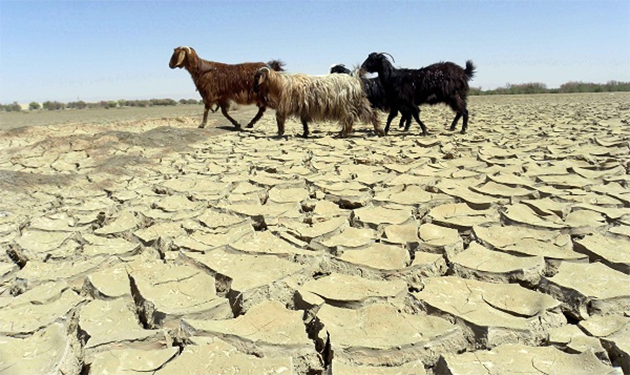Afghanistan faces serious threat of drought after several decades of steady climate change across the country. At least 22 of 34 provinces are suffering from the drought crisisand nearly three million people are expected to become severely food insecure needing humanitarian assistance for survival.Water points and fountains across the country have dried up and the lack of rain and snow melt has made rivers run low or dry up completely. Faced with the lack of water, farmers have chosen to minimize their losses by delaying planting crops and reducing field sizes. However, a drought emergency task force has been set up by the Government torespond the issue but it seems beyond their ability due to the vastness of the problem. “In many cases there was nothing farmers could do but watch the seeds dry out,” quoted from Abdul Majid, the Food Security and Agriculture Cluster (FSAC) Coordinator of UN FAO.
The drought resulted in a shortage of grazing land and drinking water, affecting almost 95% of the farmers who rely on agriculture and livestock as their main source of income and food. Children living within these communities are more vulnerable, having to miss school so that they could find small jobs to help purchase basic household items.The shortage of water and fodder resulted in the deaths of livestock. In some areas, it is reported that at least 150,000 heads of livestock have perished due to the drought.According to some media reports, thousands of people migrationhave been recorded since the beginning of May moved to urban centers. Many families have been forced to sell the items in their house to buy food.
An estimated 100 families from the Bala Murghab district of Badghis have been forced to move to Herat to find alternative work due to failed crops and to access safe drinking water. The situation is further complicated, as a result of escalating conflict that often occurs at this time of year, leading to increased displacement and reduced access for humanitarian workers. Among the affected provinces, Badghis, Bamyan, Daykundi, Ghor, Helmand, Kandahar, Jawzjan, Nangarhar, Nimroz, Nuristan, Takhar, and Uruzgan are of critical priority for nutrition and water, sanitation, and hygiene assistance. Thirteen provinces, out of a country total of 34 provinces, received less than 30 % of their average annual precipitation in the period October 2017 to end February 2018.
Authorities from Daykundi estimated that the number of people who are going to be affected by the ongoing drought are around 267,000 people, more than one third of the population of the whole province.it is said that water scarcity has displaced between 70 and 100 people within Ghorak district of Hilmand province. Thus, in Badghis, nearly 4,000 people moved to Qala-e-Naw due to the drought while they extremely need food assistance.
There are several factors that strengthen droughts and also influence water quality such as climate change, agricultural activities, increasing population, types of water supplies, embedded technology in water management sector, wastage of water, quality of sanitation activities, storage of raw water in dry season, quality of canalization network. in relevance to population growth and decreasing agricultural lands, the authorities are responsible to undertake certain measures such as prevention of water losing in traditional agricultural sectors and urban water system network, changing the consumption patterns, regulated plans for drought combating.
In case of climate change factor which is the most important one we need to draw national and international attentions as it is beyond capability of mere official units. With every passing decade, Afghanistan has lost 2 percent of its rain and snowfall due to Climate Change and its accompanying impacts on local and regional climates. Study indicate that average temperature across Afghanistan has increased by 0.6°C since 1960. This general warming across Afghanistan is in line with rising temperatures across the region in which Afghanistan is located.
In a statement released recently by the United Nations International Children’s Emergency Fund (UNICEF) reads: “the extremely dry winter has affected 22 provinces across Afghanistan and now threatens to negatively impact the lives of one million people, with an additional two million who could feel its effects over the coming months.”According to the statement, 23 - 30 % of water sources have gone dry. Food insecurity and reduced access to safe water are beginning to take their toll in the 10 worst affected provinces, where 20 to 30 % of water sources are reportedly dry. The impact on children could be devastating, as these areas have pre-existing high rates of malnutrition. Without adequate nutritious food and safe water for drinking, as well as for hygiene and sanitation, children’s health will only worsen.
As a final point, Afghanistan is suffering from multiple issues such social insecurity, corruption, addiction, chronic poverty and so on but none of which would be achieved without food security for the people of Afghanistan. It is hunger and unemployment that are partly responsible for driving the vicious cycle of war and conflicts in Afghanistan. In fact, we need to haveshort term and long term plan in order to cope with growing crisis. For short term plan, according to UNICEF, emergency nutrition assistance is needed for 92 000 children and 8 500 pregnant and lactating women. UNICEF estimates also show that between July and December 2018, some 121 000 acutely malnourished children under five and 33 000 pregnant and lactating women could need life-saving nutrition services. In long term plan, it is imperative upon the government of Afghanistan to renew its commitment to moving forward and gradual implementation of Afghanistan National Development Strategy as the country’s second most important national document after the Constitution.
Home » Opinion » Drought grips large parts of Afghanistan
Drought grips large parts of Afghanistan
| Mohammad Zahir Akbari

